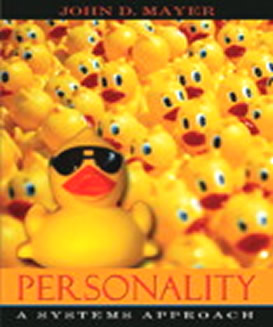Answer: Personality: A Systems Approach provides a narrative that describes the personality system. Its major sections include: (1) what personality is (and what the field is), (2) personality's parts, (3) organization, and (4) development. The book draws on cross cultural and women's theories, integrating them in the text and drawing on those ideas to illuminate its major topics.
For example, the book covers the cross cultural perspective on personality in the third chapter, "Perspectives on Personality." This chapter examines cross-cultural research, using an example of collectivism and individualism. After introducing the perspective, further cross-cultural work is introduced in strategic places throughout the text. For example, Chapter 4, on motives and emotions, discusses Ekman's cross-cultural work on emotions, and Chapter 11, on Childhood and Adolescent development, covers cross-cultural similarities and differences in the self and in gender development. For example, Chapter 11 contains a box entitled, "Cultural Influences on Child Personality," examining the differences in stories told by Chinese and American preschoolers about themselves.
Empirical research in gender development is covered both in Chapters 11 and 12 (on Childhood and Adolescent development, and in Adult Development). Chapter 11 has a section entitled, "The Gendered World," which covers the development of gender roles, including work by Williams and Best on children's understanding of gender schema, and same sex play groups. Later, the section on Sexual and Sex-Role development covers Bem's (and others') work on femininity, masculinity, and androgeny, sex differences in adolescence in same sex groups (e.g., Maticka-Tyndale et al. 1998), and (in Chapter 12) Gilligan's perspective on relatedness, as an alternative to Maslow's ideas about autonomy, in the self-actualized individual.
If a professor wished to elaborate on such themes, there would be many places to do so, including, for example, Chapter 5 on mental models, entitled, "Interior Selves; Interior Worlds."
Question: Does the book cover the biological bases of personality?
Answer: The book, Personality: A Systems Approach, uses a new field-wide framework for introducing students to personality psychology. The book covers four topics: (1) personality’s definition, (2) its parts (3) how personality is organized, and (4) how it develops. Biological perspectives are explained and drawn upon throughout the treatment. (The new field-wide framework followed by the book has been described in a number of journal articles, appearing in Psychological Inquiry (in 1997), the American Psychologist (in 2005), and the Journal of Personality (in 1998); for details, see www.personalitysystem.com).
Part 1 of Personality: A Systems Approach is entitled Exploring Personality Psychology, and it introduces the biological perspective, along with situational, and social perspectives on personality.
The book’s first chapter “What is Personality?” locates personality amidst its neighboring systems of scientific study, including the brain, the situation, and social groups.
Still in Part 1, a (brief) section of Chapter 2, Research in Personality Psychology, discusses data that arises from each of the areas surrounding personality: that is, biomedical, situational, and institutional data on the person. Biomedical data is produced from such sources as brain scans, measures of neurotransmitters, genetic testing, and the like.
Chapter 3, Perspectives on Personality, divides traditional perspectives on personality into four areas: those that are (1) primarily biological, (2) psychological, (3) social, or (4) developmental in their emphasis. The biological perspective is illustrated with two specific areas of theorizing: psychoevolutionary theories and biopsychological approaches. Both of these are, in turn, illustrated with specific examples of research investigations. Chapter 3 marks the conclusion of the first part of the book.
Biological perspectives continue to be discussed throughout the remaining three parts of the book, which form the book’s core: Parts of Personality, Personality Organization, and Personality Development. Topics from biological psychology are drawn upon as they illuminate the particular topic(s) under discussion.
For example, in the Parts of Personality (Part 2 of the book), the chapter “Motivation and Emotion” draws on biological conceptions of motives and emotions: motives are described as basic signals necessary to keeping the organism alive; emotions as universal and evolved signals about relationships. As a second example from this part of the book, Chapter 7, “The Conscious Self,” discusses the complex interplay of biology and mental awareness in voluntary action. Covered are Libet’s experiments, which show how patterns of electrical activity in the brain change before a person becomes conscious of making a voluntary action such as lifting one’s finger. Also considered is the debate as to whether a free will can influence the brain.
In Part 3 of the book, Personality Organization, the chapter “How the Parts of Personality Fit Together,” discusses (among other topics) biologically-based divisions of personality. For example, the division of personality into motives, emotion, and cognition (the trilogy of mind) has been related to the tri-partite evolutionary theory of the brain that divides it into the reptilian, old-mammalian, and new-mammalian brains (that is, MacLean’s theory). As another example from Part 3, the chapter, “Dynamics of Action” discusses the biology of communication channels – from the sensory and motor areas of the brain (where Freud believed the ego originated) to external motor action in the form of language, facial expressions, posture, and the like.
In Personality Development (Part 4 of the book), the chapter, “Personality Development in Childhood and Adolescence” discusses temperament theory, beginning with the work of Thomas, Birch, and Chess, and updating it with current work. The chapter, “Personality Development in Adulthood” talks about evolutionary mating strategies that people use to find significant others, and compares those approaches with compatible social explanations.
In all, biological approaches to personality, along with social approaches, are developed throughout the discussion of personality, its parts, organization, and development.

